Understanding MERS-CoV: Transmission, Symptoms, and Prevention
VerifiedAdded on 2021/04/17
|7
|1621
|69
AI Summary
This assignment provides an in-depth analysis of Middle East Respiratory Syndrome Coronavirus (MERS-CoV), including its transmission methods, symptoms, and prevention measures. The document covers the virus's single-stranded RNA structure, its ability to infect camels and humans, and its high fatality rate with potential for multi-organ failure. Research on MERS-CoV is ongoing, focusing on developing vectors that can modify cell lysis properties or coat proteins to prevent attachment to host cell membranes. The assignment also highlights the importance of hand hygiene in healthcare settings and preventive measures for travelers.
Contribute Materials
Your contribution can guide someone’s learning journey. Share your
documents today.
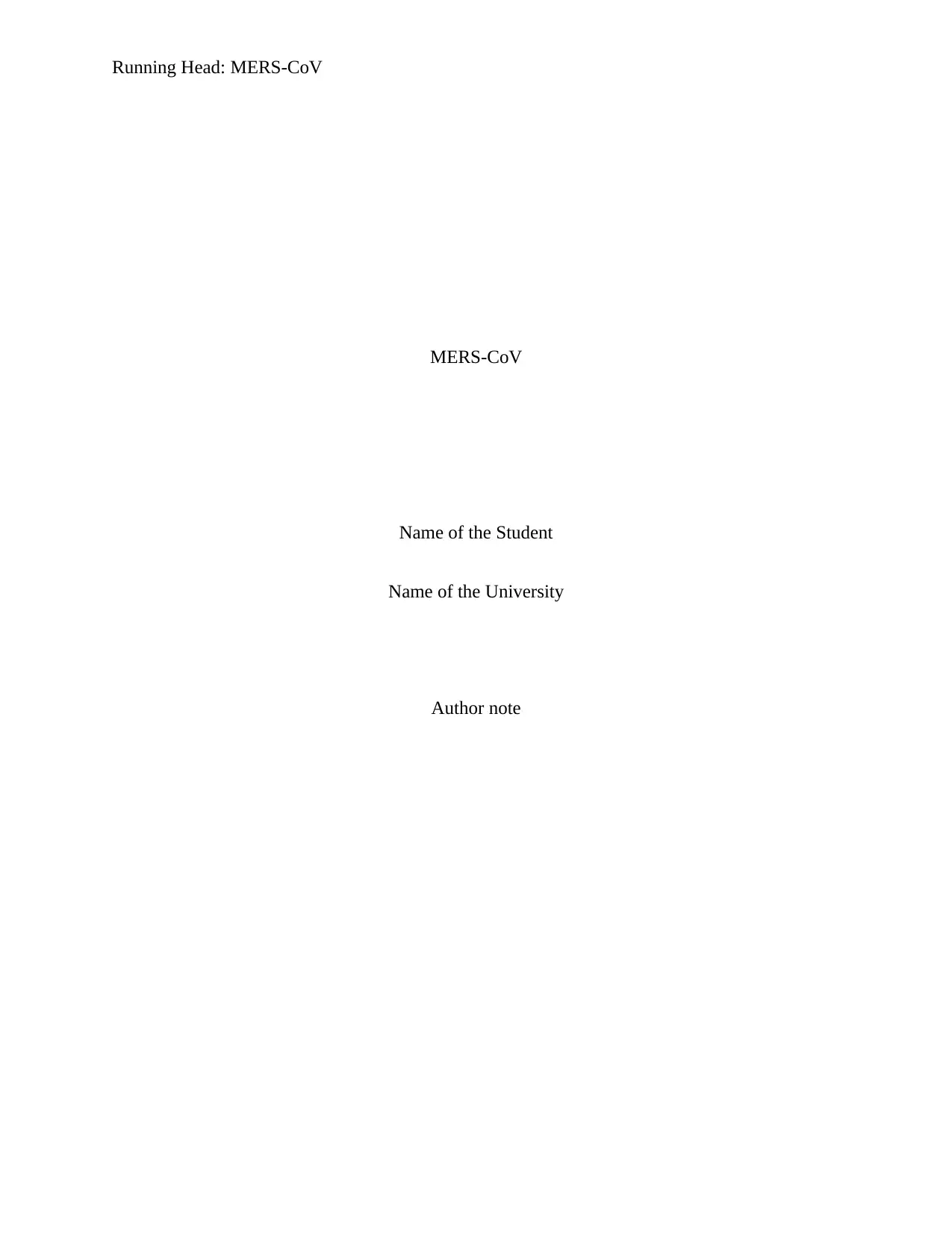
Running Head: MERS-CoV
MERS-CoV
Name of the Student
Name of the University
Author note
MERS-CoV
Name of the Student
Name of the University
Author note
Secure Best Marks with AI Grader
Need help grading? Try our AI Grader for instant feedback on your assignments.
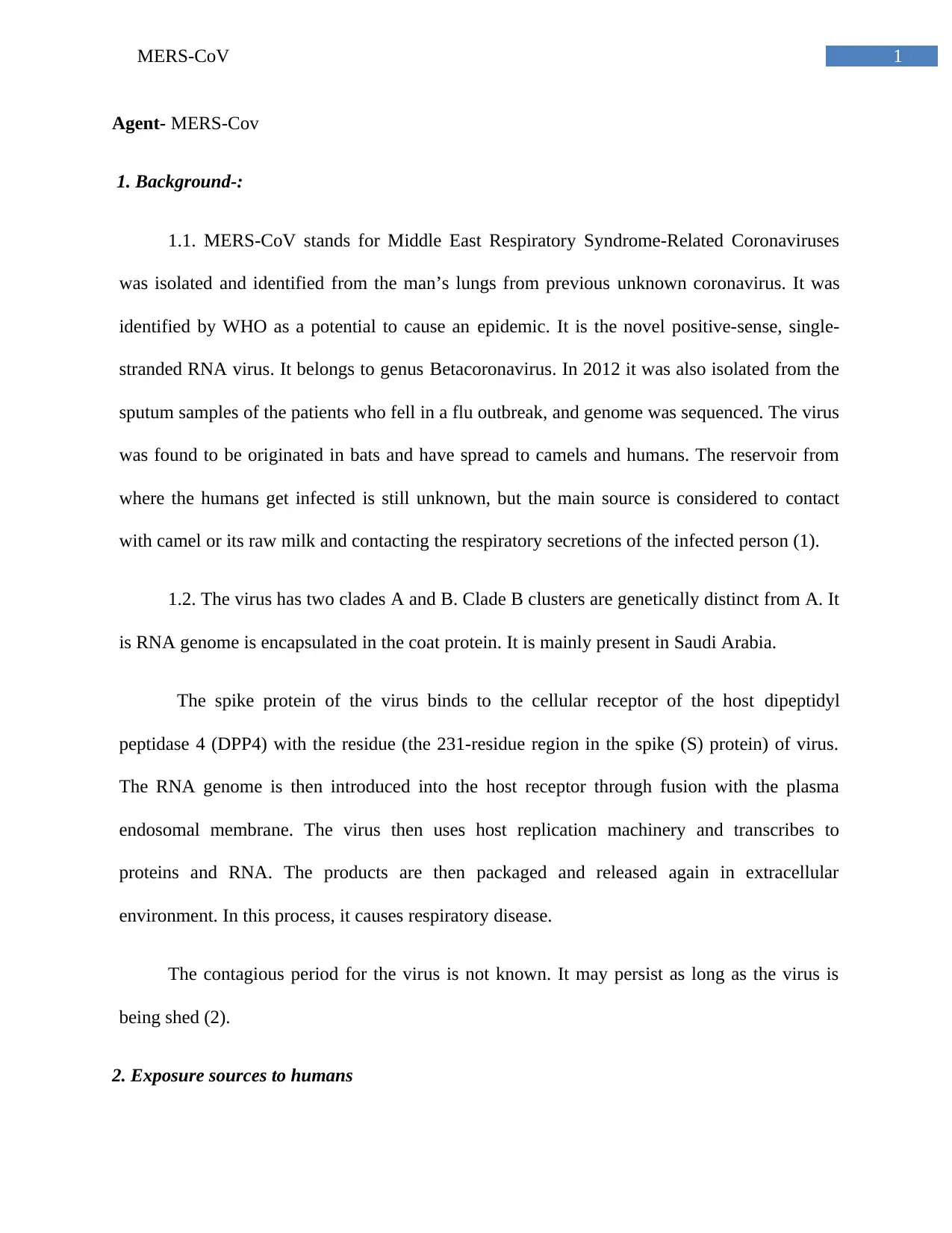
1MERS-CoV
Agent- MERS-Cov
1. Background-:
1.1. MERS-CoV stands for Middle East Respiratory Syndrome-Related Coronaviruses
was isolated and identified from the man’s lungs from previous unknown coronavirus. It was
identified by WHO as a potential to cause an epidemic. It is the novel positive-sense, single-
stranded RNA virus. It belongs to genus Betacoronavirus. In 2012 it was also isolated from the
sputum samples of the patients who fell in a flu outbreak, and genome was sequenced. The virus
was found to be originated in bats and have spread to camels and humans. The reservoir from
where the humans get infected is still unknown, but the main source is considered to contact
with camel or its raw milk and contacting the respiratory secretions of the infected person (1).
1.2. The virus has two clades A and B. Clade B clusters are genetically distinct from A. It
is RNA genome is encapsulated in the coat protein. It is mainly present in Saudi Arabia.
The spike protein of the virus binds to the cellular receptor of the host dipeptidyl
peptidase 4 (DPP4) with the residue (the 231-residue region in the spike (S) protein) of virus.
The RNA genome is then introduced into the host receptor through fusion with the plasma
endosomal membrane. The virus then uses host replication machinery and transcribes to
proteins and RNA. The products are then packaged and released again in extracellular
environment. In this process, it causes respiratory disease.
The contagious period for the virus is not known. It may persist as long as the virus is
being shed (2).
2. Exposure sources to humans
Agent- MERS-Cov
1. Background-:
1.1. MERS-CoV stands for Middle East Respiratory Syndrome-Related Coronaviruses
was isolated and identified from the man’s lungs from previous unknown coronavirus. It was
identified by WHO as a potential to cause an epidemic. It is the novel positive-sense, single-
stranded RNA virus. It belongs to genus Betacoronavirus. In 2012 it was also isolated from the
sputum samples of the patients who fell in a flu outbreak, and genome was sequenced. The virus
was found to be originated in bats and have spread to camels and humans. The reservoir from
where the humans get infected is still unknown, but the main source is considered to contact
with camel or its raw milk and contacting the respiratory secretions of the infected person (1).
1.2. The virus has two clades A and B. Clade B clusters are genetically distinct from A. It
is RNA genome is encapsulated in the coat protein. It is mainly present in Saudi Arabia.
The spike protein of the virus binds to the cellular receptor of the host dipeptidyl
peptidase 4 (DPP4) with the residue (the 231-residue region in the spike (S) protein) of virus.
The RNA genome is then introduced into the host receptor through fusion with the plasma
endosomal membrane. The virus then uses host replication machinery and transcribes to
proteins and RNA. The products are then packaged and released again in extracellular
environment. In this process, it causes respiratory disease.
The contagious period for the virus is not known. It may persist as long as the virus is
being shed (2).
2. Exposure sources to humans
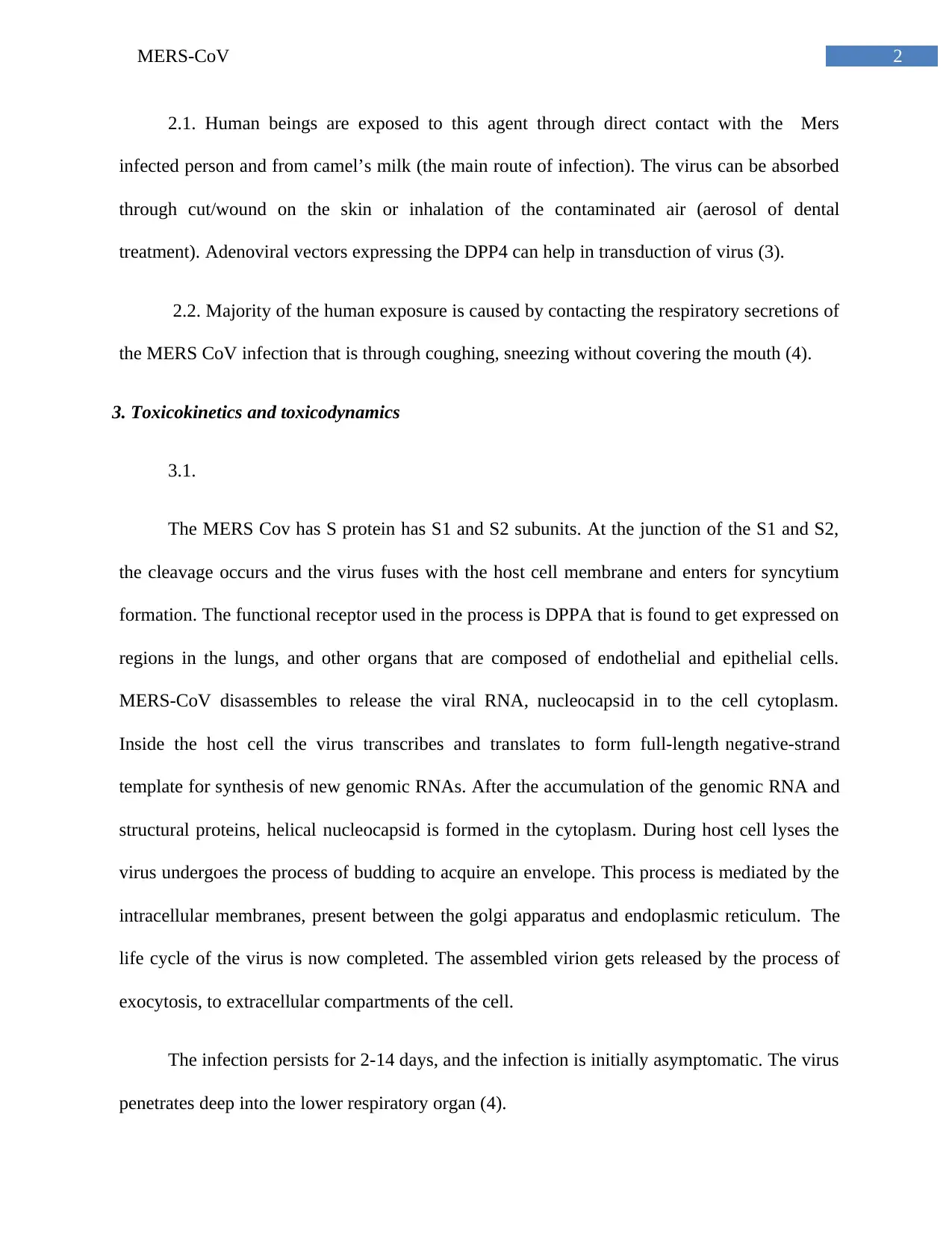
2MERS-CoV
2.1. Human beings are exposed to this agent through direct contact with the Mers
infected person and from camel’s milk (the main route of infection). The virus can be absorbed
through cut/wound on the skin or inhalation of the contaminated air (aerosol of dental
treatment). Adenoviral vectors expressing the DPP4 can help in transduction of virus (3).
2.2. Majority of the human exposure is caused by contacting the respiratory secretions of
the MERS CoV infection that is through coughing, sneezing without covering the mouth (4).
3. Toxicokinetics and toxicodynamics
3.1.
The MERS Cov has S protein has S1 and S2 subunits. At the junction of the S1 and S2,
the cleavage occurs and the virus fuses with the host cell membrane and enters for syncytium
formation. The functional receptor used in the process is DPPA that is found to get expressed on
regions in the lungs, and other organs that are composed of endothelial and epithelial cells.
MERS-CoV disassembles to release the viral RNA, nucleocapsid in to the cell cytoplasm.
Inside the host cell the virus transcribes and translates to form full-length negative-strand
template for synthesis of new genomic RNAs. After the accumulation of the genomic RNA and
structural proteins, helical nucleocapsid is formed in the cytoplasm. During host cell lyses the
virus undergoes the process of budding to acquire an envelope. This process is mediated by the
intracellular membranes, present between the golgi apparatus and endoplasmic reticulum. The
life cycle of the virus is now completed. The assembled virion gets released by the process of
exocytosis, to extracellular compartments of the cell.
The infection persists for 2-14 days, and the infection is initially asymptomatic. The virus
penetrates deep into the lower respiratory organ (4).
2.1. Human beings are exposed to this agent through direct contact with the Mers
infected person and from camel’s milk (the main route of infection). The virus can be absorbed
through cut/wound on the skin or inhalation of the contaminated air (aerosol of dental
treatment). Adenoviral vectors expressing the DPP4 can help in transduction of virus (3).
2.2. Majority of the human exposure is caused by contacting the respiratory secretions of
the MERS CoV infection that is through coughing, sneezing without covering the mouth (4).
3. Toxicokinetics and toxicodynamics
3.1.
The MERS Cov has S protein has S1 and S2 subunits. At the junction of the S1 and S2,
the cleavage occurs and the virus fuses with the host cell membrane and enters for syncytium
formation. The functional receptor used in the process is DPPA that is found to get expressed on
regions in the lungs, and other organs that are composed of endothelial and epithelial cells.
MERS-CoV disassembles to release the viral RNA, nucleocapsid in to the cell cytoplasm.
Inside the host cell the virus transcribes and translates to form full-length negative-strand
template for synthesis of new genomic RNAs. After the accumulation of the genomic RNA and
structural proteins, helical nucleocapsid is formed in the cytoplasm. During host cell lyses the
virus undergoes the process of budding to acquire an envelope. This process is mediated by the
intracellular membranes, present between the golgi apparatus and endoplasmic reticulum. The
life cycle of the virus is now completed. The assembled virion gets released by the process of
exocytosis, to extracellular compartments of the cell.
The infection persists for 2-14 days, and the infection is initially asymptomatic. The virus
penetrates deep into the lower respiratory organ (4).
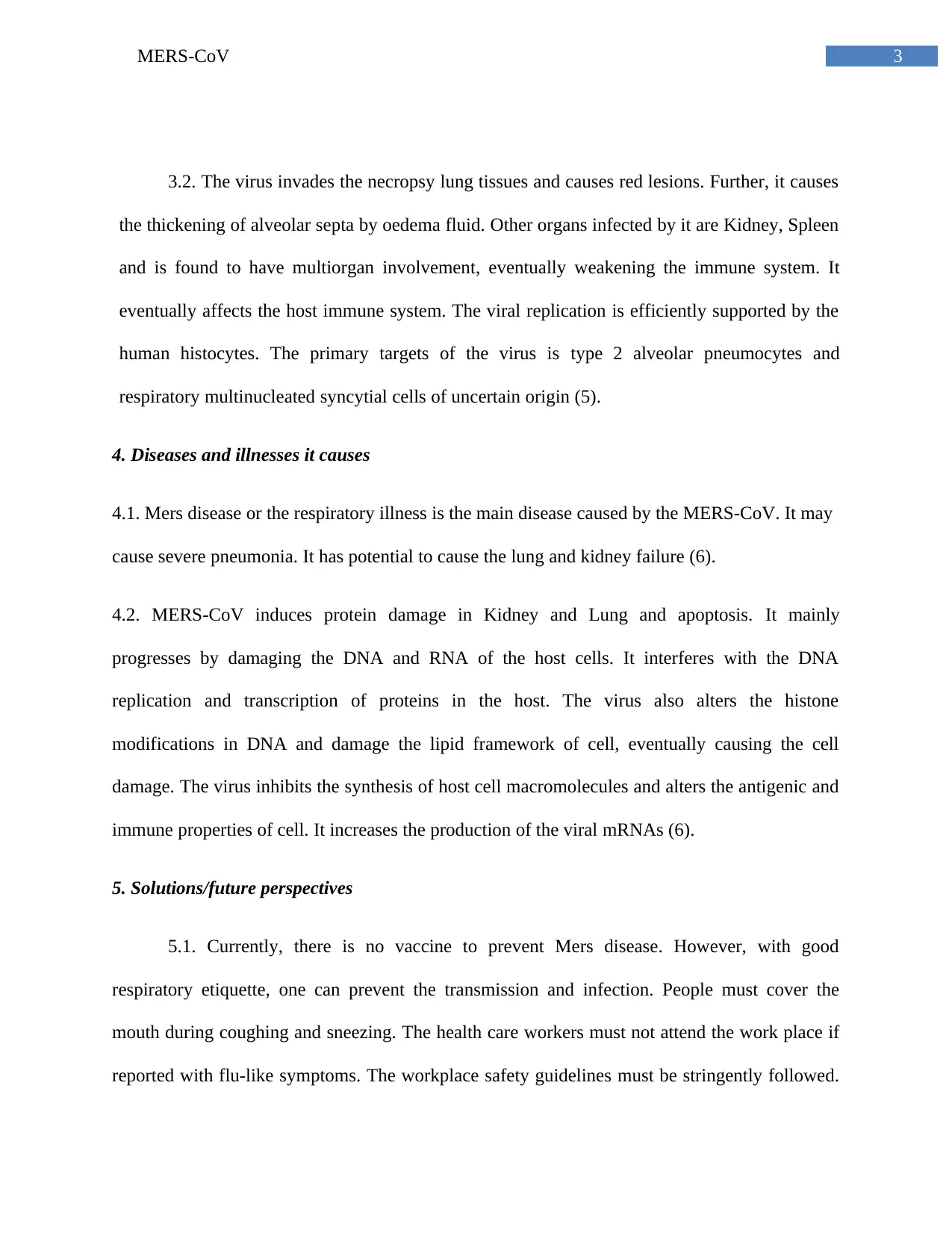
3MERS-CoV
3.2. The virus invades the necropsy lung tissues and causes red lesions. Further, it causes
the thickening of alveolar septa by oedema fluid. Other organs infected by it are Kidney, Spleen
and is found to have multiorgan involvement, eventually weakening the immune system. It
eventually affects the host immune system. The viral replication is efficiently supported by the
human histocytes. The primary targets of the virus is type 2 alveolar pneumocytes and
respiratory multinucleated syncytial cells of uncertain origin (5).
4. Diseases and illnesses it causes
4.1. Mers disease or the respiratory illness is the main disease caused by the MERS-CoV. It may
cause severe pneumonia. It has potential to cause the lung and kidney failure (6).
4.2. MERS-CoV induces protein damage in Kidney and Lung and apoptosis. It mainly
progresses by damaging the DNA and RNA of the host cells. It interferes with the DNA
replication and transcription of proteins in the host. The virus also alters the histone
modifications in DNA and damage the lipid framework of cell, eventually causing the cell
damage. The virus inhibits the synthesis of host cell macromolecules and alters the antigenic and
immune properties of cell. It increases the production of the viral mRNAs (6).
5. Solutions/future perspectives
5.1. Currently, there is no vaccine to prevent Mers disease. However, with good
respiratory etiquette, one can prevent the transmission and infection. People must cover the
mouth during coughing and sneezing. The health care workers must not attend the work place if
reported with flu-like symptoms. The workplace safety guidelines must be stringently followed.
3.2. The virus invades the necropsy lung tissues and causes red lesions. Further, it causes
the thickening of alveolar septa by oedema fluid. Other organs infected by it are Kidney, Spleen
and is found to have multiorgan involvement, eventually weakening the immune system. It
eventually affects the host immune system. The viral replication is efficiently supported by the
human histocytes. The primary targets of the virus is type 2 alveolar pneumocytes and
respiratory multinucleated syncytial cells of uncertain origin (5).
4. Diseases and illnesses it causes
4.1. Mers disease or the respiratory illness is the main disease caused by the MERS-CoV. It may
cause severe pneumonia. It has potential to cause the lung and kidney failure (6).
4.2. MERS-CoV induces protein damage in Kidney and Lung and apoptosis. It mainly
progresses by damaging the DNA and RNA of the host cells. It interferes with the DNA
replication and transcription of proteins in the host. The virus also alters the histone
modifications in DNA and damage the lipid framework of cell, eventually causing the cell
damage. The virus inhibits the synthesis of host cell macromolecules and alters the antigenic and
immune properties of cell. It increases the production of the viral mRNAs (6).
5. Solutions/future perspectives
5.1. Currently, there is no vaccine to prevent Mers disease. However, with good
respiratory etiquette, one can prevent the transmission and infection. People must cover the
mouth during coughing and sneezing. The health care workers must not attend the work place if
reported with flu-like symptoms. The workplace safety guidelines must be stringently followed.
Secure Best Marks with AI Grader
Need help grading? Try our AI Grader for instant feedback on your assignments.
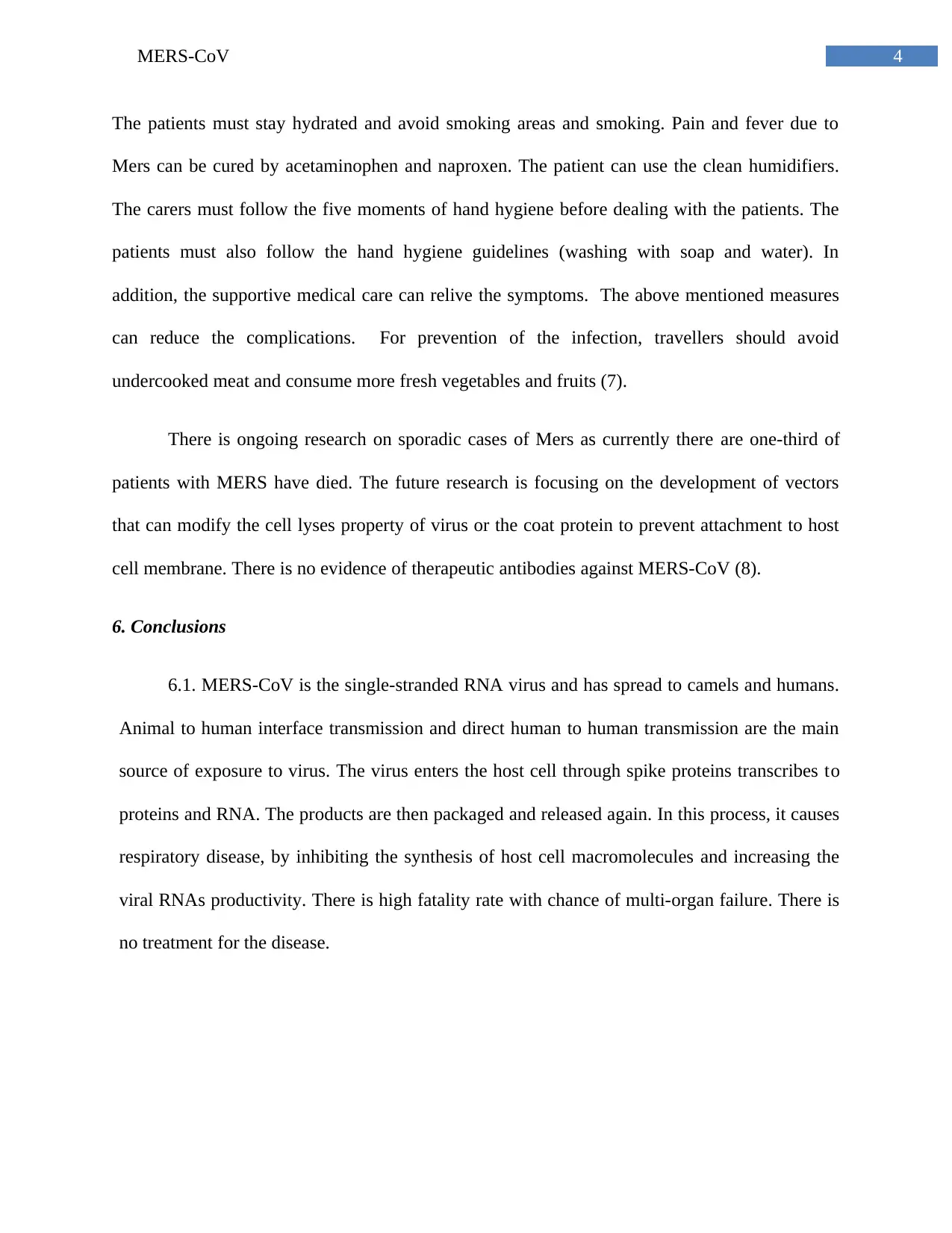
4MERS-CoV
The patients must stay hydrated and avoid smoking areas and smoking. Pain and fever due to
Mers can be cured by acetaminophen and naproxen. The patient can use the clean humidifiers.
The carers must follow the five moments of hand hygiene before dealing with the patients. The
patients must also follow the hand hygiene guidelines (washing with soap and water). In
addition, the supportive medical care can relive the symptoms. The above mentioned measures
can reduce the complications. For prevention of the infection, travellers should avoid
undercooked meat and consume more fresh vegetables and fruits (7).
There is ongoing research on sporadic cases of Mers as currently there are one-third of
patients with MERS have died. The future research is focusing on the development of vectors
that can modify the cell lyses property of virus or the coat protein to prevent attachment to host
cell membrane. There is no evidence of therapeutic antibodies against MERS-CoV (8).
6. Conclusions
6.1. MERS-CoV is the single-stranded RNA virus and has spread to camels and humans.
Animal to human interface transmission and direct human to human transmission are the main
source of exposure to virus. The virus enters the host cell through spike proteins transcribes to
proteins and RNA. The products are then packaged and released again. In this process, it causes
respiratory disease, by inhibiting the synthesis of host cell macromolecules and increasing the
viral RNAs productivity. There is high fatality rate with chance of multi-organ failure. There is
no treatment for the disease.
The patients must stay hydrated and avoid smoking areas and smoking. Pain and fever due to
Mers can be cured by acetaminophen and naproxen. The patient can use the clean humidifiers.
The carers must follow the five moments of hand hygiene before dealing with the patients. The
patients must also follow the hand hygiene guidelines (washing with soap and water). In
addition, the supportive medical care can relive the symptoms. The above mentioned measures
can reduce the complications. For prevention of the infection, travellers should avoid
undercooked meat and consume more fresh vegetables and fruits (7).
There is ongoing research on sporadic cases of Mers as currently there are one-third of
patients with MERS have died. The future research is focusing on the development of vectors
that can modify the cell lyses property of virus or the coat protein to prevent attachment to host
cell membrane. There is no evidence of therapeutic antibodies against MERS-CoV (8).
6. Conclusions
6.1. MERS-CoV is the single-stranded RNA virus and has spread to camels and humans.
Animal to human interface transmission and direct human to human transmission are the main
source of exposure to virus. The virus enters the host cell through spike proteins transcribes to
proteins and RNA. The products are then packaged and released again. In this process, it causes
respiratory disease, by inhibiting the synthesis of host cell macromolecules and increasing the
viral RNAs productivity. There is high fatality rate with chance of multi-organ failure. There is
no treatment for the disease.
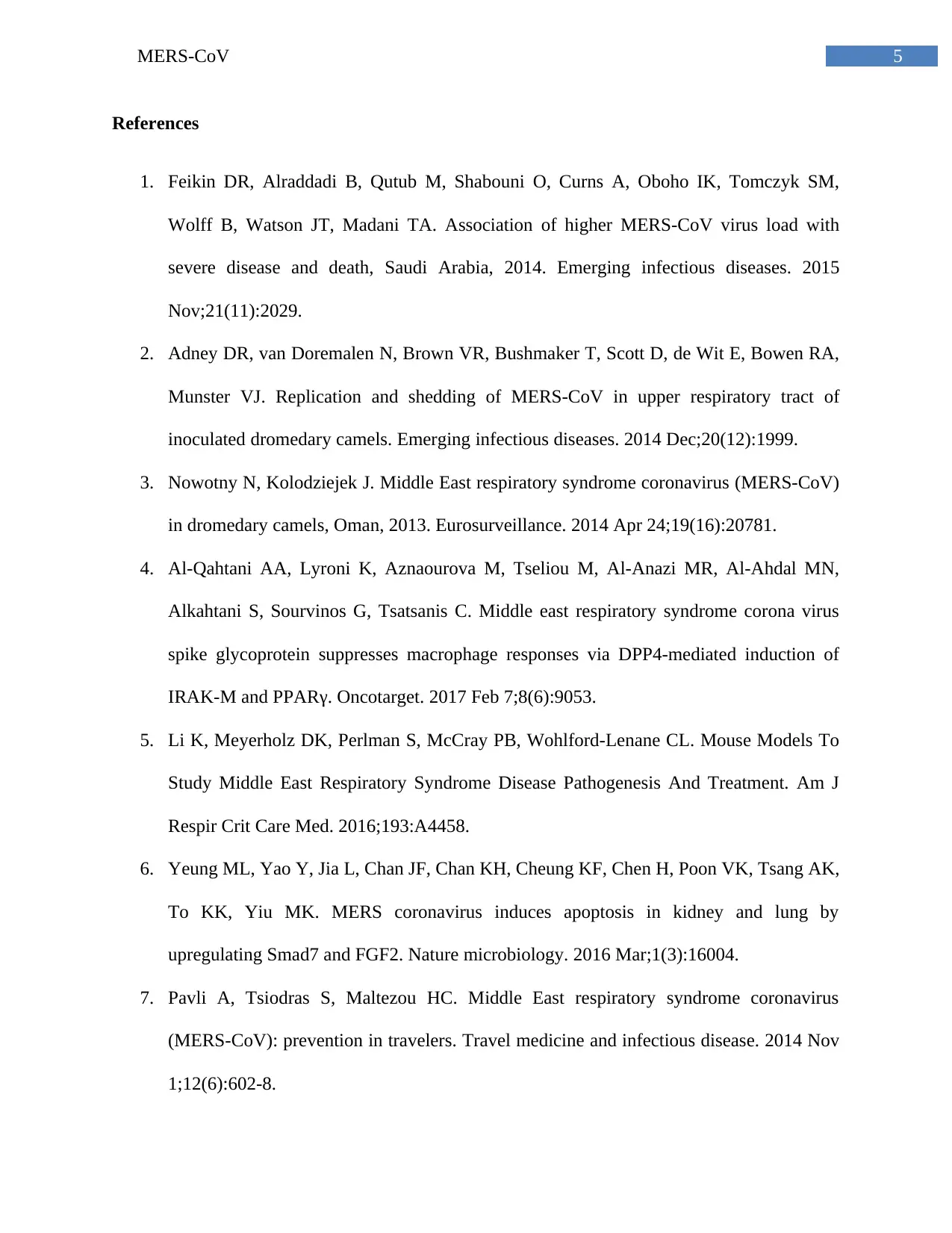
5MERS-CoV
References
1. Feikin DR, Alraddadi B, Qutub M, Shabouni O, Curns A, Oboho IK, Tomczyk SM,
Wolff B, Watson JT, Madani TA. Association of higher MERS-CoV virus load with
severe disease and death, Saudi Arabia, 2014. Emerging infectious diseases. 2015
Nov;21(11):2029.
2. Adney DR, van Doremalen N, Brown VR, Bushmaker T, Scott D, de Wit E, Bowen RA,
Munster VJ. Replication and shedding of MERS-CoV in upper respiratory tract of
inoculated dromedary camels. Emerging infectious diseases. 2014 Dec;20(12):1999.
3. Nowotny N, Kolodziejek J. Middle East respiratory syndrome coronavirus (MERS-CoV)
in dromedary camels, Oman, 2013. Eurosurveillance. 2014 Apr 24;19(16):20781.
4. Al-Qahtani AA, Lyroni K, Aznaourova M, Tseliou M, Al-Anazi MR, Al-Ahdal MN,
Alkahtani S, Sourvinos G, Tsatsanis C. Middle east respiratory syndrome corona virus
spike glycoprotein suppresses macrophage responses via DPP4-mediated induction of
IRAK-M and PPARγ. Oncotarget. 2017 Feb 7;8(6):9053.
5. Li K, Meyerholz DK, Perlman S, McCray PB, Wohlford-Lenane CL. Mouse Models To
Study Middle East Respiratory Syndrome Disease Pathogenesis And Treatment. Am J
Respir Crit Care Med. 2016;193:A4458.
6. Yeung ML, Yao Y, Jia L, Chan JF, Chan KH, Cheung KF, Chen H, Poon VK, Tsang AK,
To KK, Yiu MK. MERS coronavirus induces apoptosis in kidney and lung by
upregulating Smad7 and FGF2. Nature microbiology. 2016 Mar;1(3):16004.
7. Pavli A, Tsiodras S, Maltezou HC. Middle East respiratory syndrome coronavirus
(MERS-CoV): prevention in travelers. Travel medicine and infectious disease. 2014 Nov
1;12(6):602-8.
References
1. Feikin DR, Alraddadi B, Qutub M, Shabouni O, Curns A, Oboho IK, Tomczyk SM,
Wolff B, Watson JT, Madani TA. Association of higher MERS-CoV virus load with
severe disease and death, Saudi Arabia, 2014. Emerging infectious diseases. 2015
Nov;21(11):2029.
2. Adney DR, van Doremalen N, Brown VR, Bushmaker T, Scott D, de Wit E, Bowen RA,
Munster VJ. Replication and shedding of MERS-CoV in upper respiratory tract of
inoculated dromedary camels. Emerging infectious diseases. 2014 Dec;20(12):1999.
3. Nowotny N, Kolodziejek J. Middle East respiratory syndrome coronavirus (MERS-CoV)
in dromedary camels, Oman, 2013. Eurosurveillance. 2014 Apr 24;19(16):20781.
4. Al-Qahtani AA, Lyroni K, Aznaourova M, Tseliou M, Al-Anazi MR, Al-Ahdal MN,
Alkahtani S, Sourvinos G, Tsatsanis C. Middle east respiratory syndrome corona virus
spike glycoprotein suppresses macrophage responses via DPP4-mediated induction of
IRAK-M and PPARγ. Oncotarget. 2017 Feb 7;8(6):9053.
5. Li K, Meyerholz DK, Perlman S, McCray PB, Wohlford-Lenane CL. Mouse Models To
Study Middle East Respiratory Syndrome Disease Pathogenesis And Treatment. Am J
Respir Crit Care Med. 2016;193:A4458.
6. Yeung ML, Yao Y, Jia L, Chan JF, Chan KH, Cheung KF, Chen H, Poon VK, Tsang AK,
To KK, Yiu MK. MERS coronavirus induces apoptosis in kidney and lung by
upregulating Smad7 and FGF2. Nature microbiology. 2016 Mar;1(3):16004.
7. Pavli A, Tsiodras S, Maltezou HC. Middle East respiratory syndrome coronavirus
(MERS-CoV): prevention in travelers. Travel medicine and infectious disease. 2014 Nov
1;12(6):602-8.
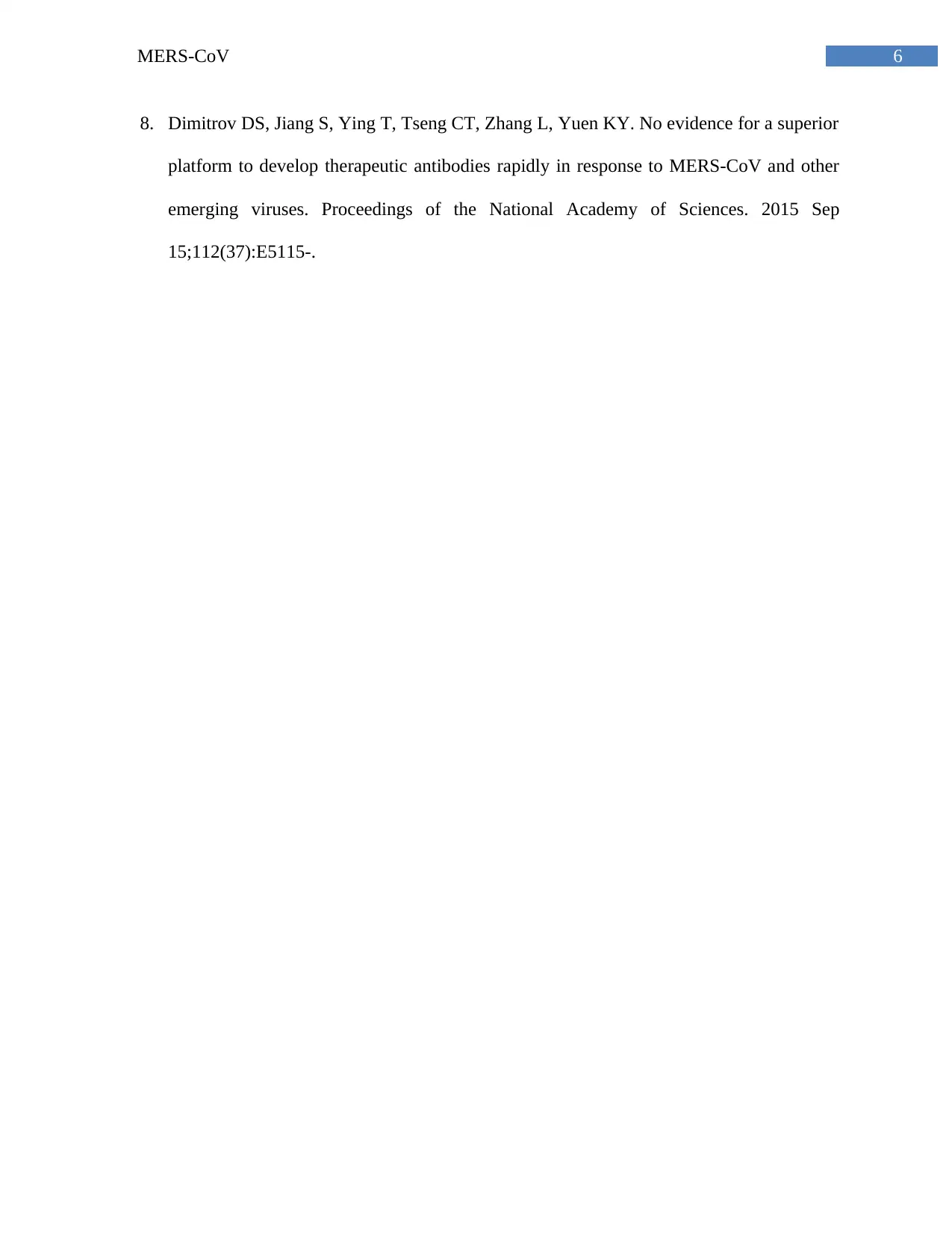
6MERS-CoV
8. Dimitrov DS, Jiang S, Ying T, Tseng CT, Zhang L, Yuen KY. No evidence for a superior
platform to develop therapeutic antibodies rapidly in response to MERS-CoV and other
emerging viruses. Proceedings of the National Academy of Sciences. 2015 Sep
15;112(37):E5115-.
8. Dimitrov DS, Jiang S, Ying T, Tseng CT, Zhang L, Yuen KY. No evidence for a superior
platform to develop therapeutic antibodies rapidly in response to MERS-CoV and other
emerging viruses. Proceedings of the National Academy of Sciences. 2015 Sep
15;112(37):E5115-.
1 out of 7
Your All-in-One AI-Powered Toolkit for Academic Success.
+13062052269
info@desklib.com
Available 24*7 on WhatsApp / Email
![[object Object]](/_next/static/media/star-bottom.7253800d.svg)
Unlock your academic potential
© 2024 | Zucol Services PVT LTD | All rights reserved.


